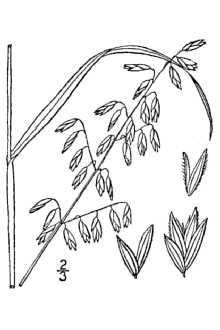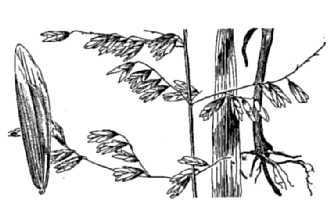Threeflower Melicgrass
Scientific Name: Melica nitens (Scribn.) Nutt. ex Piper

| General Information | |
|---|---|
| Usda Symbol | MENI |
| Group | Monocot |
| Life Cycle | Perennial |
| Growth Habits | Graminoid |
| Native Locations | MENI |
Plant Guide
Description
General: Threeflower melicgrass is a native cool-season perennial bunchgrass. Stems grow between 20 to 47 inches (50-120 cm) tall in small clumps formed from rhizomes (Correll and Johnston 1970, Gould 1978, Silveus 1933) (Fig. 1.). Sheaths are hairless to minutely hairy with fused margins to form a tubular sheath casing. Ligules are membranous and grow 0.10 to 0.25 inches (0.3-0.6 cm) long; blades are hairless or minutely hairy, flat, and grow 0.10 to 0.60 inches (0.3-1.5 cm) wide; inflorescence are open panicles usually 4.0 to 10 inches (10-26 cm) long; the lower branches typically re-branch outward and upward; and spikelets are 0.3 to 0.6 inches (0.8-1.5 cm) long with one to four seed-bearing florets (Gould 1975, Correll and Johnston 1970, Hitchcock 1950). Florets are erect or nearly erect at maturity, and the tip of the second floret typically exceeds the tip of the first by 0.04 to 0.08 inches (0.1-0.2 cm). Glumes are shorter than the spikelet, broadly or narrowly pointed, thin on the margins and at the tip. First glumes range from 0.20 to 0.28 inches (0.5-0.7 cm) long, and the second glumes are narrower and longer (0.28 to 0.35 inches (0.7-0.9 cm)) than the first glumes. Lemmas are minutely rough with thin, narrow margins and a broad or narrow pointed tip; furthermore, lemmas of lower florets are approximately 0.31 to 0.43 inches (0.8-1.1 cm) long (, Gould 1975, Correll and Johnston 1970, Hitchcock 1950, Silveus 1933). Plants typically mature seed from May to June (Gould, 1978 and Powell 1994). Distribution: Threeflower melicgrass is found from Pennsylvania to Kansas, and as far south as Texas. In Texas, it is distributed in the Cross Timbers and Prairies, Edwards Plateau, Rolling Plains, High Plains, and Trans Pecos ecoregions (Gould 1975). For current distribution, please consult the Plant Profile page for this species on the PLANTS Web site. Habitat: Threeflower melicgrass is found in the central and western regions of the state on relatively undisturbed sites in open pastures and woodlands, moist canyon slopes and valley bottoms, and rocky grasslands (Gould 1975).
Adaptation
Threeflower melicgrass is adapted to a wide variety of soils but tends to prefer partial shade and calcareous or sandy loam soils.
Uses
Threeflower melicgrass is recommended for critical area stabilization. It can be added to range and pasture plantings due to its high palatability to all classes of livestock and for wildlife habitat improvement.
Status
Please consult with your local NRCS Field Office, Cooperative Extension Service office, state natural resource, or state agriculture department regarding its status and use. Please consult the PLANTS Web site and your State Department of Natural Resources for this plant’s current status (e.g., threatened or endangered species, state noxious status, and wetland indicator values). Natural Resources Conservation Service Plant Guide Fig. 1. Typical plant of threeflower melicgrass.
Planting Guidelines
Begin seedbed preparation well in advance of planting, Establish a clean, weed-free seedbed by either tillage or herbicides, Prior to planting, the site should be firmed and have accumulated soil moisture, Use soil test recommendations to correct nutrient deficiencies prior to planting, Plant threeflower melicgrass in late summer or early fall at a seeding rate of 3,7 pure live seed (PLS)/acre for drill plantings or 4,8 PLS lb/acre for broadcast plantings (20 seeds per ft2), If broadcast seeded, some type of additional coverage such as cultipacking or light dragging is recommended to cover the seed and ensure good seed-to-soil contact, Adjust the seeding rate of threeflower melic to the desired percent in the mixture, Plant seed ⅛ to ¼ inch deep, It is better to plant too shallow than too deep, For calibration purposes, threeflower melicgrass contains approximately 235,700 seeds/lb, Use soil moisture sensors to measure the soil moisture of Threeflower Melicgrass.,
Management
Defer grazing 90 days after planting to allow plants to become well establish. For assistance with a prescribed grazing plan, contact the local NRCS Field Office. Threeflower melicgrass readily reseeds itself with minimal soil disturbance. Allow plants to produce seed annually to maintain stand health.
Pests and Potential Problems
There are no potential problems or pests associated with threeflower melicgrass.
Environmental Concerns
Concerns
Concerns
There are no environmental concerns associated with threeflower melicgrass.
Control
Please contact your local agriculture extension agent or extension weed specialist to learn what herbicides work best for weed control in your area and how to use them safely. Always read label and safety instructions for each control method. Trade names and control measures appear in this document only to provide specific information. USDA NRCS does not guarantee or warranty the products and control methods named, and other products may be equally effective.
Seeds and Plant Production
Plant Production
Plant Production
Threeflower melicgrass is best started using greenhouse grown transplants or direct seeding into bedded rows (fig. 2). Transplants grow and mature quickly and often produce a marketable seed crop in the year of planting. For seed production fields established from seed, plant 3.7 PLS/lb acre on rows wide enough to accommodate equipment for weed control and seed harvest. Seed harvest is possible using a variety of methods and implements. Because seed ripens indeterminately, a brush-like harvester collects the ripe seed crop without damaging or eliminating the ability to make subsequent harvests as later flowering florets mature. Seed matures in late spring so harvests should be in May and June. At the James E. “Bud” Smith Plant Materials Center in Knox City, Texas, average seed yield of Centex Germplasm is 40-60 PLS/acre on 40-inch bedded rows using a Native Seedster harvester (Native Seedsters, Inc., Billings, MT). Cultivars, Improved, and Selected Materials (and area of origin) Centex Germplasm threeflower melicgrass was released in 2021 by the NRCS, James E. “Bud” Smith Plant Materials Center, Knox City, Texas. This release is made up of six collections originating from the Cross Timbers and Prairies, Edwards Plateau, and Rolling Plains ecoregions of Texas. It is recommended for critical site revegetation, erosion control, wildlife plantings and inclusion in range and pasture seeding mixes. Cultivars are selected based on the local climate, resistance to local pests, and intended use. Consult with your local land grant university, local extension or local USDA NRCS office for recommendations on adapted cultivars for use in your area.
Literature Cited
Correll, D.S. and M.C. Johnston. 1970. Manual of the Vascular Plants of Texas. Texas Research Foundation. Renner, Texas. Gould, F.W. 1975. The Grasses of Texas. Texas A&M University Press. College Station, Texas. Gould, F.W. 1978. Common Texas Grasses; An Illustrated Guide. Texas A&M University Press. College Station, Texas. Fig. 2. Seed production field of threeflower melic established from transplants. Hitchcock, A.S. 1950. Manual of the Grasses of the United States. United States Department of Agriculture. Washington, D.C. Powell, A.M. 1994. Grasses of the Trans-Pecos and Adjacent Areas. University of Texas Press. Austin, Texas. Silveus, W.A. 1933. Texas Grasses. The CLEGG Company. San Antonia, Texas. Citation Wiggans, D.R. and C.B. Carr. 2021. Plant Guide for threeflower melicgrass (Melica nitens). USDA-Natural Resources Conservation Service, James E. “Bud” Smith Plant Materials Center. Knox City, Texas, 79529. Published July 2021 For more information about this and other plants, please contact your local NRCS field office or Conservation District at http://www.nrcs.usda.gov/ and visit the PLANTS Web site at http://plants.usda.gov/ or the Plant Materials Program web site: http://plant-materials.nrcs.usda.gov. PLANTS is not responsible for the content or availability of other Web sites. In accordance with Federal civil rights law and U.S. Department of Agriculture (USDA) civil rights regulations and policies, the USDA, its Agencies, offices, and employees, and institutions participating in or administering USDA programs are prohibited from discriminating based on race, color, national origin, religion, sex, gender identity (including gender expression), sexual orientation, disability, age, marital status, family/parental status, income derived from a public assistance program, political beliefs, or reprisal or retaliation for prior civil rights activity, in any program or activity conducted or funded by USDA (not all bases apply to all programs). Remedies and complaint filing deadlines vary by program or incident. Persons with disabilities who require alternative means of communication for program information (e.g., Braille, large print, audiotape, American Sign Language, etc.) should contact the responsible Agency or USDA's TARGET Center at (202) 720-2600 (voice and TTY) or contact USDA through the Federal Relay Service at (800) 877-8339. Additionally, program information may be made available in languages other than English. To file a program discrimination complaint, complete the USDA Program Discrimination Complaint Form, AD-3027, found online at How to File a Program Discrimination Complaint and at any USDA office or write a letter addressed to USDA and provide in the letter all of the information requested in the form. To request a copy of the complaint form, call (866) 632-9992. Submit your completed form or letter to USDA by: (1) mail: U.S. Department of Agriculture, Office of the Assistant Secretary for Civil Rights, 1400 Independence Avenue, SW, Washington, D.C. 20250-9410; (2) fax: (202) 690-7442; or (3) email: program.intake@usda.gov. USDA is an equal opportunity provider, employer, and lender.

